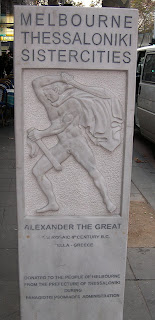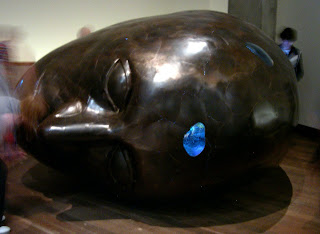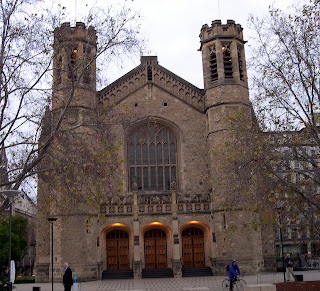Everyone who has been to Tasmania agrees it is a delightful place. It is significantly different than the other Aussie states: more southern and rugged, with similarities to New Zealand especially the South Island. It was the second state colonized after New South Wales, and has a dark history of brutal penal colonies and near-extermination of native aborigines. Its reputation was so tainted that in 1856 they decided after 214 years to change the name from Van Diemen’s Land to Tasmania for PR purposes. Despite this, present-day Tassie is a beautiful place with friendly people.
It is winter here, and a strong Antarctic storm the day before we arrived brought snow and ice, so it was nippy. Hobart is the capital on a deep natural harbor with a brisk and clean atmosphere.
 |
| Sullivans Cove, Hobart |
Rarely when traveling am I truly caught unaware. Things may be new, unusual, not as predicted, but not often is something completely unexpected. In Tasmania, this happened twice, one delightful, the second not so much. I’ll discuss #1 now: more on #2 later.
On arrival at our hotel, we were told there is a new museum upstream from Hobart, and that we HAD to visit. It is called the
Museum of New and Old Art (MONA). It opened in January 2011 and is the pet project of eccentric, mysterious, and fabulously wealthy
David Walsh There are several ways to get to the museum, but the most fun is a 30 minute cruise up the Derwent River, out of the harbor past the bridges
 |
| Cenotaph and Mt. Wellington, Hobart |
and one of the world’s largest zinc refineries.
The museum site also has a 5 star hotel, fancy restaurant, winery, and brewery, but admission is free. You are brought in boluses of 20-30 people and are issued an i-Touch but no other instructions or labels. This added to a sense of mystery and discovery, with a heavily controlled feeling. (It's Mr. Walsh's house: you play by his rules.) You can access a variety of information about the artworks you are near. The collection represents a uniquely personal vision of its benefactor. There are ultra-modern works, videos, installations, conceptual art, other things even harder to describe, mixed with some ancient objects.
 |
| Meso-American Pottery |
Although he denies it, Mr. Walsh’s interests seem to run heavily to sex and death, presented with a wicked sense of humor. Appropriately, an i-Touch guide entry from the host quotes Woody Allen. The most startling project is called
Cloaca Professional, a labor of love by Belgian Wim Delvoye, who has constructed a series of tubes and flasks filled with bacteria, fed twice a day, which mimics the function of the human gastrointestinal tract.
And if you are there at 2 PM, you can see the product of this machine expelled.
It is mechanical feces, but is it art?
The building itself is a wonder, on four or five levels, apparently dug into the sandstone. One station featured water programmed to spell out apparently random but charged words, like “killer”.
It was very cool, but very hard to catch with my camera.
A giant human head had porthole and a kind of lightshow inside.
On display also were lots of experimental films and a comically puffed-up
Fat Car Porsche.
I can only hint at how “mind-blowing” the afternoon was, one of the most fascinating museums I have ever visited. It is free to visit, so I don’t know how sustainable it will be, but I would say if you are down in southern Australia, it is worth a trip to Tasmania just to visit this place.
There are more traditional tourist attractions, like the Saturday Salamanca Market, held amidst 19
th century warehouses.
The mood is festive, with loads of local produce and handicrafts, and the food alluring, like these tiny pancakes.
 |
| Cole's Bay |
 |
| The Hazards |
 |
| Great Oyster Bay |
We were to spend four nights in Tasmania, so we rented a car to get out into the countryside. One of the most photographed beaches in the country is at Wineglass Bay in Freycinet National Park, which is a 2 ½ hour drive from Hobart. The drive up featured several seaside vistas points and views of the rocky hills called the Hazards.
You have to walk up to a saddle to see Wineglass Bay, and even though the weather wasn’t the best, it was worth it.
 |
| Wineglass Bay |
On Sunday we drove to the Southeastern corner of the island, to
Port Arthur, former home of a notoriously prison. Like the former penal colony in New Caledonia we visited on the Ile des Pins, the Tasman peninsula is cruelly beautiful. It is connected to the rest of the island by the very slender isthmus called Eaglehawk Neck.
The old prison grounds are mostly in ruins, but stately and quiet now.


Admission includes a short cruise on the bay to see the first British Boys Prison, as well as the cemetery at the Isle of the Dead.
We learned on our visit of a much more recent
bloody massacre. On a Sunday in 1996 an obviously deranged 28 yo Aussie from Hobart came load with plenty of guns and ammo, and in a very short time mowed down 35 innocents. His motives are unclear, but in part he seemed to have need inspired by an infamous Scottish Dunblane schoolyard slaughter six weeks before.
 |
| Memorial place and pool at a site of the massacre |
During our guided tour,
Big Tassie Surprise #2 was revealed. Our guide casually noted “if you are planning to fly to Melbourne, all flights have been cancelled due to the volcano in Chile”. This was the first clue we had that we might not be catching our 6:05 am flight the next day. I had heard of the volcano the previous week but had no idea there would be a problem. The skies appeared clear and blue. It was hard to believe, but true that all Qantas flights out of Tasmania would be cancelled for the next four days do to safety concerns from high-altitude volcanic ash. We would have to scramble to change plans in order to get to Melbourne in time for our Thursday June 16 flight back to the USA. The only travel alternative was to catch the ferry from Devonport on the opposite (i.e.: north) side of the island, and even that was booked up until Tuesday night. There was some symmetry in this volcanic inconvenience. At the beginning of our sabbatical our flight to French Polynesia was delayed by the April 2010 Icelandic volcano.
As they repeat endlessly throughout Australasia, “no worries”. We extended the use of the rental car and arranged drop-off in the north. The result was two days to explore the Midlands, Tasmania’s central fertile pastoral lands. 18
th century settlers cleared the forest and established farms and Georgian villages. They are cherished by the residents, and new wineries and B&Bs are sprouting up. Oatlands is proud of its restored 1937 Callington Mill, which grinds organic flour.
Ross is up the road a piece, known for the third oldest bridge in Australia, built in 1836 with convict labor and featuring fine stone carvings.
Several other well-preserved sandstone Georgian churches and mansions add to the local charm.
Ross also was the site of a colonial woman’s prison, Ross Female factory.

The road led to Tasmania’s second city, Launceston, which sits at the head of the Tamar Valley where two rivers meet. We walked up the icy South Esk River through Cataract Gorge, a rare white water river near the center of a city.
It was worth the drive up the Tamar River to visit Platypus House. This was our last chance to see real live platypuses (also acceptable plural
platypodi) while in their homeland. We were delighted to finally get up close and personal with these
montremes
as well as their cousins the echidnas. Edwina was particularly playful.
 |
| Edwina the Echidna |
I even found
this video of Edwina in action.
We got to Devonport in plenty of time to catch the Spirit of Tasmania ferry for the overnight sailing to Melbourne.
We would be disappointed to have only one day there instead of three, but circumstances gave us two additional days in fascinating Tasmania.
































































